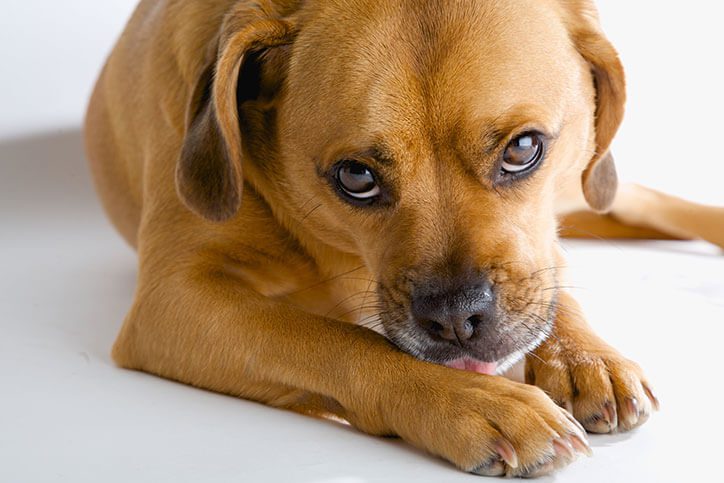Causes, Symptoms, and Treatment of Yeast Infection on Dog Paws
Yeast infections are never fun, especially for dogs when it is on their paws! Yeast cells and bacteria can make anything itchy and irritated, causing concern because too much scratching can cause open wounds leading to the spread of bacteria and infections.
Technically though, yeast is normal; too much can cause an infection. These infections are common during the hot summer months as the humidity provides the best breeding ground for yeast. Not only that, but some dogs develop yeast infections due to genetics and allergies. Before our Livonia, MI, veterinarians can help your pup with their yeast infection worries, we need to understand what it is.

Yeast Infection Causes
The exact reason is currently unknown. However, it is usually a reaction to another condition like environmental allergies or something stopping the immune system from overproducing yeast cells.
You can also accidentally cause a yeast infection if you do not bathe your dog appropriately. For example, if you have a dog with severe allergies and the allergens are constantly on their body and skin, this can cause severe reactions that do not stop.
Since allergies are directly linked to yeast infections, it is good to consider bathing your dog at least one to two times a week if you frequently take them out.
Symptoms
The symptoms of a yeast infection in dogs is concerning. These signs look irritated and uncomfortable, which is hard to look at and watch. Usually though, it is hard to find a yeast infection in dogs because they are hidden well.
When a yeast infection occurs on your dog’s paws, it is typically between the paw padding where thin skin is. This is a hard-to-reach area, especially for dogs that have a lot of long fur. However, when you do see the reaction, you are likely to find:
- Red and dry skin
- Scaly paws
- Irritated fur
- Discharge
- Infection
- Hair loss
- Excessive licking
It is a lot easier said than done, but you should start by discouraging your dog from licking their paws. This spreads the organisms more and causes open wounds, which are very uncomfortable. The constant rubbing of already dry skin is not good for your dog’s coat either, which is likely why they are losing hair and fur.
Have you ever seen a dog wearing a cone to help them not bite or lick? Most of the time it is because they have some kind of skin infection or irritation, like a yeast infection on their paws.
Treatment
Thankfully though, yeast infections are not life threatening. While it is hard to watch your dog bite, lick, and scratch themselves in pain, know that you can use both over the counter remedies and prescribed ointments.
Some creams and remedies use anti-yeast and fungal medicines to prevent the cells from overproducing. Usually, this medication is edible and not dangerous to dogs. However, to prevent dogs from over licking their wounds, the medications and cremes often have a sour or bitter taste.
Topical antifungal creams, wipes, sprays, and shampoos are common in most pharmacies. However, if the condition is severe, you may need something stronger from our Livonia, MI, animal hospital. You can use oral medications when the yeast infection is severe and lasts for months. There are many different treatments for infections that spread.
Prevention
With just a few different techniques, you can also prevent fungal infection on your dog’s paws and skin. For example, since the biggest cause is allergies, you need to reduce your dog’s allergens. If the allergens are seasonal and hard to stay away from, you can use hypoallergenic shampoos and over the counter lotions to prevent bad outbreaks.
Not only that, but frequently bathing with antifungal shampoo at least once a week or as directed by your dog’s vet can decrease the chances, they develop this type of infection. When bathing your dog, make sure to get all parts of their body, including the paws. Since the paws are often hard to reach, they are forgotten and can immediately over produce yeast cells.
For pet owners with dogs that have wrinkles and folds, it is also good to be mindful of skin folds when bathing and drying your dog. These skin folds can harbor bacteria and other types of fungus that breeds and continues to develop in a wet and dark area, like the folds of skin.
If Your Dog Has a Yeast Infection in Their Paws, Our Livonia, MI, Animal Hospital is Here to Help
Yeast infections in a dog’s paw are uncomfortable. There are many solutions though that can combat yeast and prevent the cells from continuously reproducing. When looking for the symptoms, it is best to move around your dog’s fur so that you can find sores and red flakiness. The fur that grows on your dog’s skin is the reason it is hard to diagnose a yeast infection.
We recommend reaching out to our Livonia, MI, animal hospital team if you believe your dog has yeast on their paws. Give us a call at (734) 464-6281.

